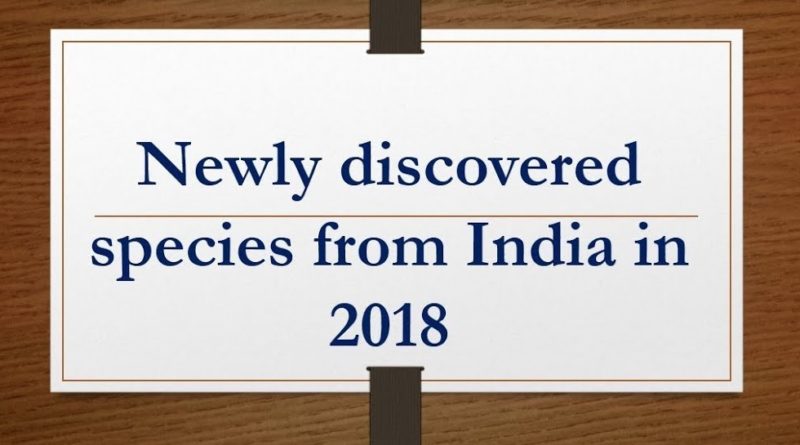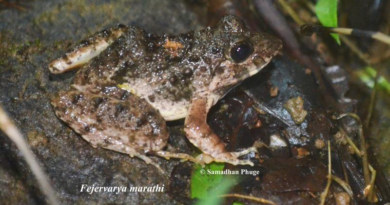A snapshot of newly discovered species from India in 2018
Over 8.7 million species are known to be found on Earth today, and many scientists believe that we have only scratched the surface. Globally, hundreds of new species were discovered in the last 2 years, including a new species of orangutan, a mystery coral snake, the deepest-dwelling fish from the Mariana Trench and a critically endangered tree from the Atlantic forests of Brazil with only 25 known individuals in the world.
In India, the year 2018 was no less eventful! Scientists here discovered several new species of frogs, reptiles, fish, plants, insects and microorganisms. Some notable findings include a new genus of freshwater crab with eleven new species from the northern Western Ghats, a new species of eel from the Bay of Bengal named after the state of Odisha and a gecko named after Prof K. VijayRaghavan, the Principal Scientific Advisor to the Government of India.
Frogs and geckos alone accounted for over 20 new discoveries this year, a result in part due to improved taxonomic methods and the use of DNA analysis to identify new species.
Most new species popped out of the Western Ghats, Himalayas and Northeast India—all known for their dense forests and diversity of wildlife. But new species also turned up from unexpected places such as a new gecko from the Northeast city of Guwahati, and a new frog from the tourist state of Goa. Many of them are already on the brink of extinction due to human-induced pressures, emphasising the need for more such discoveries before we lose them undiscovered!
1. A narrow-mouthed frog from an urban industrial area

A new species of narrow-mouthed frog was discovered in the coastal city of Mangaluru in Karnataka by researchers from Mangalore University, St. Aloysius Pre-University College and Ashoka Trust for Research in Ecology and the Environment (ATREE). Interestingly, this frog was discovered in, and is exclusively recorded from, an industrial area in the city that is surrounded by seaport, petrochemical, chemical and refinery industries. It was named Microhyla kodial after Mangaluru, which is called Kodial in Konkani. Since the industrial patch, where this frog was discovered, used to be a depot for timber imported from Southeast Asia, the researchers suggest that the frog could have been accidentally introduced with timber that came from Malaysia, Indonesia and Myanmar.
2. A new species of shieldtail snake in the Western Ghats

Researchers from the Sálim Ali Centre for Ornithology and Natural History, Coimbatore, and the Natural History Museum, London, have discovered a new species of shieldtail snake, Uropeltis bhupathyi, from the Anaikatty Hills in Coimbatore, Tamil Nadu. It is named after late herpetologist Dr. Subramanian Bhupathy, to honour his remarkable contribution in the field of herpetology. These are non-venomous, borrowing snakes found only in India and Sri Lanka. It is about 27-39 cm long and has a blackish-brown body with iridescent scales on the top, and a greyish underside and a moderate tail shield. So far, not much is known regarding the diversity, biology, and natural history of this species.
3. A new high-altitude lizard from the mountains of the Western Ghats

A new high-altitude dwelling agamid lizard was discovered by scientists from the Indian Institute of Science, Bengaluru, Bombay Natural History Society (BNHS), Mumbai, Oklahoma State University, USA, and The Natural History Museum (NHM), London. This new species, Monilesaurus montanus, named after the word ‘montane’, are restricted to the high elevation forests 1500m above the sea level, as their name suggests. These yellowish-green lizards have alternating light and dark brown patches on the back and are found in the high elevation shola forests of Kudremukh, Brahmagiri, Nilgiri and Elivalmalai. These lizards are arboreal and have small distributional ranges and pre-monsoon is believed to be their breeding season.
4. A new gecko described from a major Indian city

Cyrtodactylus guwahatiensis, named after the city of Guwahati, is the fifth gecko to be described from a major Indian city after two were found in Bengaluru and one each in Delhi and Mumbai. This discovery was made by a team of scientists from the Indian Institute of Science (IISc) and National Centre for Biological Sciences (NCBS), Bengaluru; Villanova University, USA; and the Natural History Museum (NHM), London. So far, the researchers know little about the ecology, behaviour and geographic range of these species, apart from the fact that all these geckos are nocturnal and live on rocks or walls.
5. New tiny fish discovered in the Western Ghats

A new species of badid fish, named Dario neela, is described from a stream of the Kabini River in Kerala by researchers from Kerala University of Fisheries and Ocean Studies (KUFOS), Indian Institute of Science Education and Research, Pune and The Natural History Museum, London. This tiny fish which is only about an inch long was named “neela”, which means “blue” in Hindi and some other Indian languages because of the iridescent blue colouration around the male fish’s dorsal and ventral fins.
6. A new species of water strider from Nagaland

Researchers from the Zoological Survey of India have discovered a new species of water strider named Ptilomera nagalanda from the Northeast state of Nagaland. Water striders are groups of insects with long legs covered in thousands of microscopic hairs which enable them to adapt to a life on the surface of water bodies. The new species measures about 1.2 cm long with orange and black stripes on its body and is only found in fast flowing streams.
7. New species of burrowing eel discovered in Meghalaya

A new species of swamp eel, Monopterus rongsaw was discovered in the remote forests in Meghalaya by researchers from the Natural History Museum, London and the University of Manchester, UK. It was named “rongsaw” after the Khasi word for red, referring to the blood-red colour of the eel. Interestingly, this fish was not found in water but was found burrowing in the damp soil, around 50 m from the nearest stream. Swamp eels live in caves, underground aquifers and in the soil. These bizarre eels are blind and breathe air through their mouth unlike other fish.
8. A new species of diatom from the Eastern Himalayas

Among the new species of diatoms which were discovered in the Himalayas and Western Ghats in 2018, the Gomphonema mayamae from the Eastern Himalayas was the most interesting find. Researchers from Botanical Survey of India, Agharkar Research Institute and University of Colorado Boulder were behind this discovery. Diatoms are microscopic algae which are found in water bodies all over the world. Scientists use diatoms as indicators health of water bodies and also to understand their condition in the past. The new species has a unique fringed structure in its head pole region of the girdle band. This is the first species of freshwater gomphonemoid diatom to be found with such a structure.
9. A new sub-species of endangered hog deer from India

Scientists from the Wildlife Institute of India, Dehradun, have discovered a rare sub-species of hog deer (Axis porcinus annamiticus) which was previously only known to be found in Thailand, Indo-China, Laos, Cambodia, and Vietnam. Genetic analysis of different populations of hog deer led to the finding of the first record for this sub-species in India, indicating that the western limit of hog deer’s geographic range is Manipur. The hog deer is listed as endangered in the IUCN Red List and the presence of an isolated population indicates that effective management is necessary to sustain this population.
10. New highly-threatened plant species found in the Western Ghats

A grass like plant has been discovered Agasthyamalai Biosphere Reserve by researchers from the University College, Palayam and named Fimbristylis agasthyamalaensis after the place it was found in. This plant which flowers and fruits from October to March was found to be growing at elevations of around 800 m above sea level. A preliminary assessment by the researchers revealed that this plant only has a range of about two square km with less than 50 known individuals. These plants were found to be highly threatened by grazing from wild animals and the researchers recommend it to be listed as critically endangered in the IUCN Red List.
Courtesy: researchmatters.in



